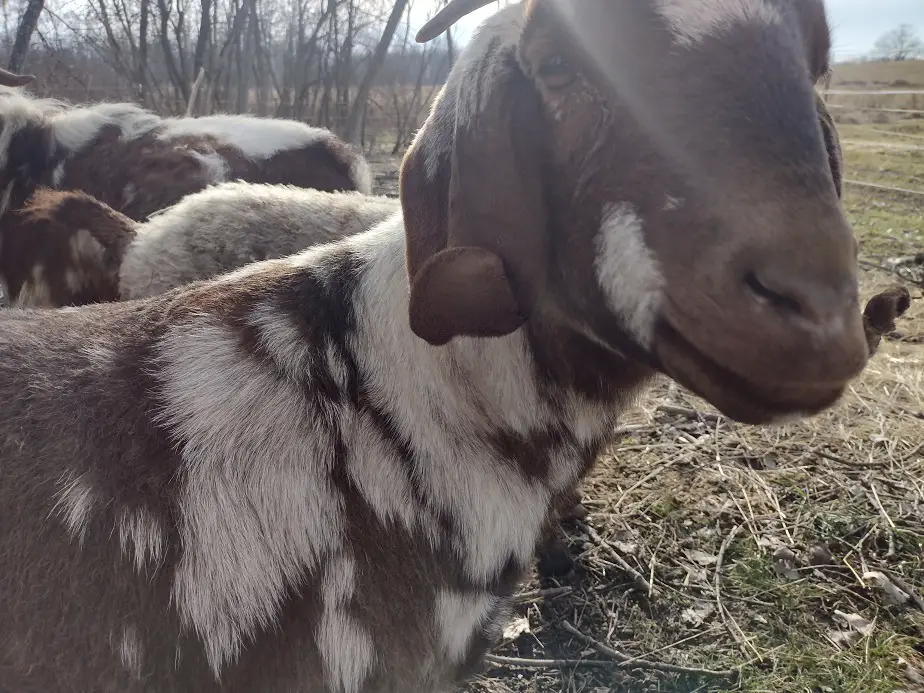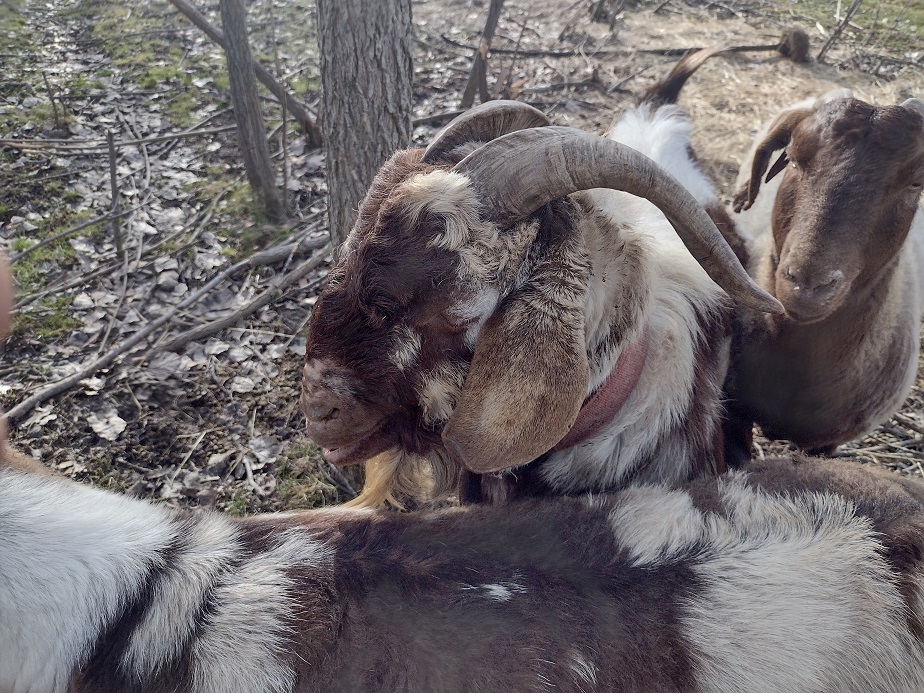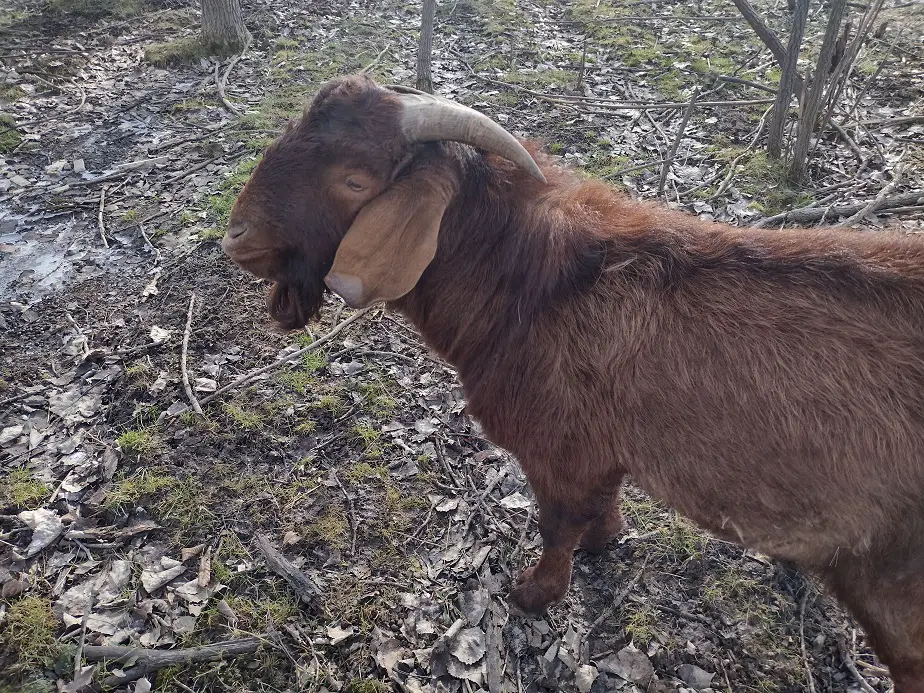Goats are probably the hardiest and most adaptable livestock out there. If you want a very hands off-animal, goats may be for you.
Most pastures will support 5 large breed adults or 10 young goats per acre if completely grass-fed. A fertile, well-managed pasture can support 20-30 growing goats per acre. With irrigation and good rotational grazing, you could potentially support even more. If fed grain, an acre will hold a significant number of goats.
Goats can be a cheap source of quality meat, but you have to watch feed costs. Grass-fed animals grow slower but have better quality meat and no feed bill.
How Many Meat Goats Per Acre?
Most people who raise goats tell me I can’t put more than 5 or 6 goats in a 1-acre pasture. If their pasture is poorly managed or not very fertile, they might be right. It’s a hard truth that most pastures are poorly managed and have suffered a lot of fertility loss because of it.
I’ve also talked with people who understand pasture management and rotational grazing and that have 15 or more goats on an acre. Personally, I think I could run 20 goats in a 1-acre pasture without much trouble, and do so in a way that would really build up the pasture quality through rotational grazing.
If you are keeping goats into adulthood as pasture pets, they’re going to need more room, but if you’re just raising a herd to butcher, it takes a lot less room. The key to grass-fed goats, or grass-fed anything, is good pasture management and preventing over-grazing. Let me give you an example of how I’d do it.
Here’s How I’d Raise 20 Meat Goats on an Acre
I can take an acre that’s been fenced in with an electric fence and use lightweight stakes and electric fencing rope to create a 50×50-foot pen that can be moved around the acre. That would give me 17 different spots to rotate the pen through.
Goats are butchered around 200 days old and are weaned at about 42 days. That means I’d have to pasture them for 158 days. Because they’re small at first, the rotation can be a bit slower. Probably something like 3 days in one spot. That’s 51 days to rotate once through the pasture.
Do that twice, then once through on a 2-day cycle. So, starting at 42 days (weaning) rotated through twice in a 3-day movement (now 144 days old) rotated once through on a 2-day movement (now 178 days old), then simply released to roam and pick through the pasture for 22 days brings them to 200 days old.
Given a decent pasture of a high-performing crop like alfalfa, that does seem doable. That would require decent soil, good rain or irrigation, and a well-established, high-protein, perennial crop. The big point of rotational posture is to never let the animals eat the pasture too low.
Given this grazing schedule and good soil, they wouldn’t eat but half of the crop that the one acre could grow. That leaves a lot to work on building up the soil and preventing erosion, as plants do.
Pasture crops grow and recover slowly when there isn’t a lot of green matter left to produce energy through photosynthesis. Ideally, you don’t want things to ever be grazed down more than 70 percent in a good pasture, and more than 50 percent in a meager pasture.
The whole idea is to both produce a lot of food and leave enough to actually build up the soil’s natural fertility instead of depleting it. When you prevent overgrazing and allow the pasture a recovery time through a rotational schedule, it will greatly increase the carrying capacity of your pasture land.
Whether you want to raise them for meat, dairy, or as pasture pets, it’s your job to practice good animal husbandry, pasture improvement, and soil conservation. It will matter to you and to generations of people after you who use that land.

How Much Meat is on a Goat?
The average goat butchered at 6 months yields between 15 and 30 pounds of meat. Some breeds may yield 50 pounds. Most breeds yield between 30 and 40 percent of live weight after butchering. Muscular breeds with concentrated feeds can yield 50 percent of live weight, up to 50 pounds of meat.
The amount you get on a goat varies greatly with age, genetics, breed, and how you raise them.
Many people consider the intensely muscular Boer goat to be the only breed suitable for meat production. But, 20 years ago no one had ever heard of them. Still, most goats in the world raised for meat are a more traditional-looking animal. Boers are also quite expensive.
I’m not sure I’d raise Boers. They are expensive and have higher feed requirements that can be tough in a true pasture-raised setting. Now, if you wanted to purchase and feed them concentrated feeds, that’s fine. I won’t do that because it’s the most expensive way to feed an aminal.
We need things to be less expensive than the grocery store, so pasture-fed if we’re only raising them for us, but if we’re selling at least some of them for pets or to be butchered, then concentrated feeds may be worth it. I can raise a Boer on pasture, it’s just going to perform a bit less.
Honestly, If you’re new at it then I recommend you look around for whatever is available cheap in your area. That will get you started and let you build up some experience before you put down big money. Even the miniature or pigmy-breed goats are raised for meat in many countries.
Realize T=that it’s not practical to buy a single goat to raise it for meat. They are too expensive for that. Instead, you’d want breeding adults. Female goats average 2 kids a litter and 2 litters a year. One male can service several females.
With 4 goats a year per breeding female, let’s see what can pe produced. For large breeds at 30 to 50 pounds of meat each, that’s 120 to 200 pounds of meat a year. Smaller, more traditional breeds yielding 15 to 25 pounds each can give you 60 to 100 pounds a year per breeding female.

How Much do Goats Eat?
A meat goat will eat about 200 pounds of feed on a dry matter basis by 6 months if pasture-fed. Goats generally eat 2.5 percent of their body weight daily in dry feed matter. Pregnant or nursing does can eat 4 percent of their body weight daily.
So, 200 pounds of dry matter eh? What’s that look like? In a thick growing pasture, one inch of plant matter is approximately 200 pounds dry matter per acre. So, if you have three feet of dense growth over an acre, you could estimate 4,000 or 5,000 pounds of grazing matter and still leave a foot for re-growth.
Now, when grazing animals on pasture, you should never let them eat it very low. Our local agricultural extension says to graze pasture down no lower than 6 inches. That’s the extreme low end. If you keep it taller, it will spring back faster. Don’t graze pasture too low.
If your pasture is becoming over-grazed, you’re going to have to consider expanding it, cutting back on your animals, or buying supplemental feed. The cheapest option to supplement feed is a round bale of good hay. Round bales are usually 2-4 times cheaper per pound than small square bales.
But, they usually weigh 800 to 1000 pounds, or more. You can put one in a pasture and open it up for the animals to chew through, rip off a daily feeding amount and bring it to them. That way, there will be a lot less waste. but it will take more of your time.
You can also give goats grains or a cheap all-stock feed. Just a few options. Corn and oats are usually pretty cheap around here, at least from the farmer. The hobby farm stores have inflated prices on grains. A lot of people give some basic grains like corn, and add a bit of agricultural molasses if needed.
That is just a simple way to up the calories in an animal’s diet. Personally, I won’t add molasses or use a sweet feed unless an animal needs to gain weight quickly or it’s a cold winter and I need to feed extra calories to get them by. I do use molasses, but mainly as a catalyst in fermenting grains for the pigs.
Related Articles:

